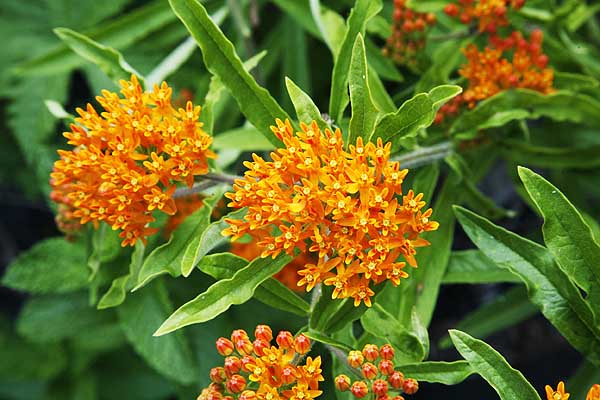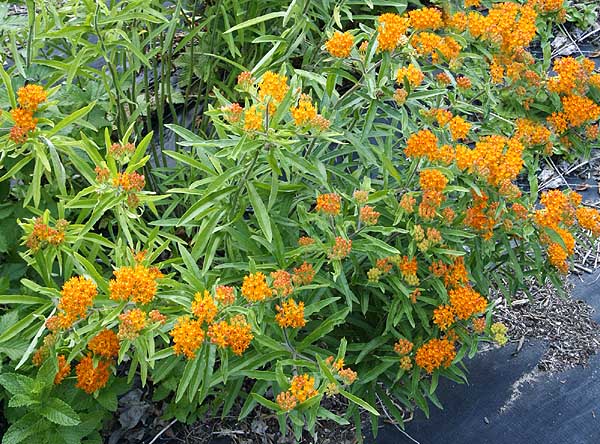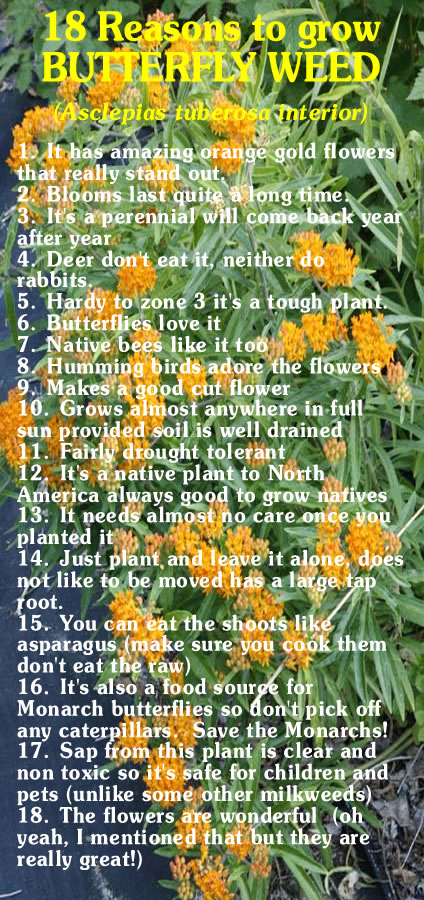Butterfly weed also known as butterfly milkweed or Pleurisy root is an essential must have native plant for almost any garden. Its bright orange flowers bloom throughout the summer months and bring lasting color with very little care or management. It likes full sun but can grow on almost any kind of soil and is pretty drought tolerant. It can grow where many other plants don't, not only that but its deer and rabbit proof! Hardy to zone 3 what more could you want from any plant.
It prefers sandy slightly acid soils but will grown on almost anything except poorly drained soil. It is a very easy plant and once established needs no other care. It is beloved by butterflies - hence its name - and is an essential plant for monarch butterflies. It also makes a great cut flower and once established continues to bloom for a long period of time.
Description of Butterfly weed (Asclepias tuberosa interior).
Butterfly weed is a perennial, it dies down in the wintertime but then comes
back every year. It is hardy to zone 3 and will grown anywhere from 1 to three
feet in height depending on location, soil and water availability. Young plants
may have only one central stem but as the bush matures it will produce many
stems and create more of a bush like appearance. The leaves are alternate medium
green to yellowish green and slightly shiny even though they have tiny hairs
on them. They are up to 4 inches in length, ½ inch wide and linear lancate
in shape. The upright stems terminate in flat umbels of small five petaled oranged
flowers that bloom from July until September. The plant will often flower in
the first year from seed but with only a few flowers and often intermittently,
as the plant matures more flowers are produce over a longer period of time.
Deadheading the plant can increase the number of flowers and reduce seed pod
production. Seed pods are large up to 4-5 inches long and up to 1" thick.
These will spilt open when the seeds are ripe to release seeds the size of a
pencil end attached to a fluffy 'parachute' which catch on the wind. Removing
these before they disperse over your entire garden is usually a good idea. If
removed while still green they can be used in decorative dried flower arrangements.
Unlike other plants in the milkweed family butterfly weed has a clear sap with very low levels of the toxic substance found in most milkweeds so it is a much safer plant for children and pets.
Growing Butterfly weed (Asclepias tuberosa interior) from seed.
Butterfly weed seeds need to be stratified before they will germinate.
Its not a difficult task but it does mean a little more care needs to be taken
to get them to grow. Read our stratification
instructions before you sow this seed. We keep all our seeds refrigerated
before shipping them to you so they are semi pre-stratified before they reach
you, however they do need to have a period of moist cold before they will germinate.
This can be achieved artificially by sowing or you can sow them in place in
the fall and allow nature to stratify them over the winter months.
Either method works well but sowing in place needs a little more care weeding
before the seeds germinate. Germination can be a little erratic some seeds germinate
quickly and others may take several weeks to months. Don't throw away the seed
tray too early or you may loose half your plants.
If growing in pots wait until the tiny roots begin to show through the bottom
of the individual pot that you have used to grow the plant on then plant in
the ground (after hardening off) see general
growing instructions for details on growing seedlings. Choose your location
well because butterfly weed does not like to be transplanted and once established
its set in place. Dig a hole large enough to accommodate the size of the pot
you are using the carefully turn the plant out of the pot so as to disturb as
little of the roots system as possible. These plants don't like to be moved
so its vital that the roots are disturbed as little as possible.
Location and Care of Butterfly weed (Asclepias tuberosa interior).
Choose your location carefully butterfly weed develops large tap roots and does
not like to be transplanted or moved so the location you choose is going to
be its permanent home. While plants can be transplanted they really don't do
well and can take years to recover and flower again.
Butterfly weed must have full sun in order to flourish. It really prefers sandy soil that is slightly acid but it will grow almost anywhere that is well drained including on rocks. Too much moisture will often turn the lower leaves yellow or rot the taproot so if planting on a clay soil ensure you amend it to create sufficient drainage. It is fairly drought resistant but may need a little supplementation if the drought continues for too long in order for the taproot to survive. It's a pretty tough plant, once established it really does not need any care at all. Cutting down the plant in the late fall will ensure its looks its best the following year but that's about all you have to do.
Wildlife and Butterfly weed (Asclepias tuberosa interior).
Because of its nectar content butterfly weed is loved by most butterflies especially
monarchs and swallowtails but almost any butterfly will stop by for a drink
as will bumblebees, honeybees and native bees. Humming birds are also drawn
to the plant. Butterfly weed or Pleurisy root is also an important food source
for the caterpillars of the Monarch Butterfly (Danaus plexippus). The beautiful
striped caterpillars will be seen on most plants chomping on the leaves for
the most part they do little damage unless the plant is very small then they
may defoliate it entirely. The best option is to grow several close together
so caterpillars can transfer from plant to plant and not eat one to the ground.
Deer and rabbits avoid the plant due to the bitter toxic compounds in the leaves,
the same compounds that the caterpillars store to pass on to the butterflies
making them distasteful to predators.
Edible uses of Butterfly weed (Asclepias tuberosa interior).
Surprisingly this plant is edible. Both the flower buds and shoots if cooked
can be eaten. The shoots like asparagus and the flowers apparently taste like
peas although I have yet to try this. However the plant is toxic if eaten raw,
always cook or par-boil the plant before eating, never eat anything raw. No
part should be eaten in large quantities however as this can cause vomiting.
The flower clusters which, produce prolific amounts of nectar, can be boiled
down to make a sugary syrup. The nectar production is so prolific in fact that
in hot weather it crystallizes out into small lumps which can be eaten like
sweets, the nectar is not toxic raw.
Other uses of Butterfly weed (Asclepias tuberosa interior).
The fluffy seed material is very water repellant and was used as a stuffing
material in jackets as a substitute for a kapok since it is very warm. It has
also been used in life jackets and to mop up oil spills at sea.
Medicinal uses of Butterfly weed (Asclepias tuberosa interior).
Butterfly weed has been used medicinally by Native Americans for centuries.
Known as Pleurisy root it acquired a reputation as a heal-all amongst the earlier
white settlers since it has so many uses. It was used for a range of lung diseases
as well as diarrhoea, dysentery, rheumatism. A poultice of the dried, powdered
roots is used in the treatment of swellings, bruises, and wounds.
Other names
Pleurisy root, Butterfly Milkweed.








